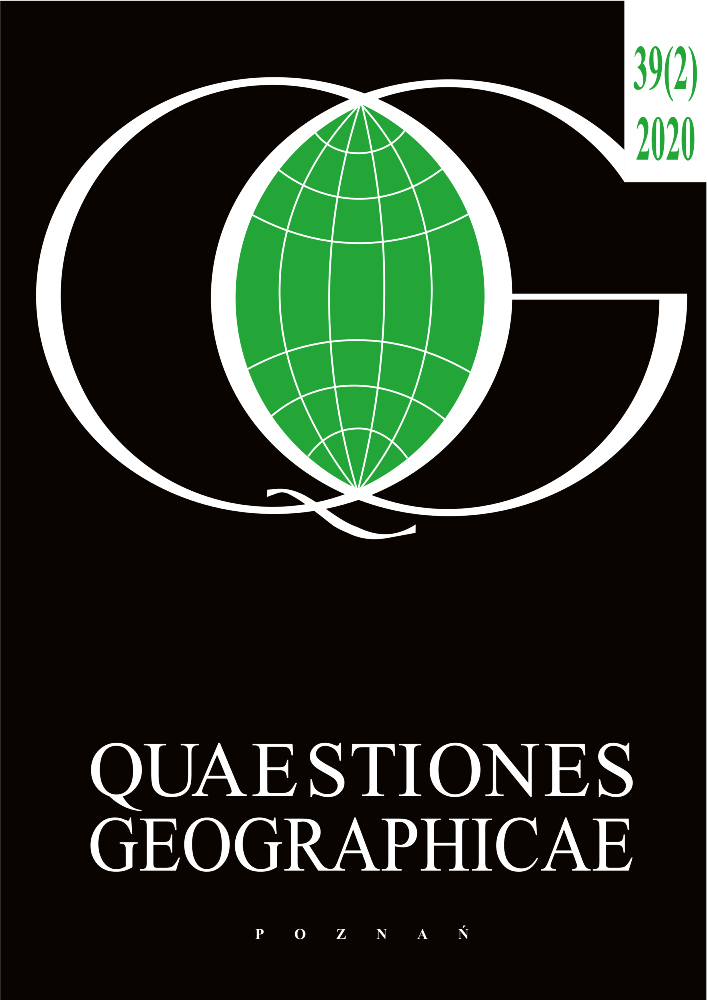Abstract
The purpose of this study was to identify compatibilities of land-use patterns resulting from adjacent functions within the rural commune of Oleśnica. The analysis was made based on the relevant studies of conditions and directions of spatial planning, as well as a field inventory. The results of the studies show that the applicable planning document became a potential source of spatial conflicts. On these grounds, a negative assessment was given to the functioning spatial planning system, which, according to the premises of spatial order and sustainable development, should prevent them. The existing incompatibilities are the result of issues with coordination of the local spatial policies. As a consequence, they cause an urban development chaos, lack of proper space shaping, environmental damage and lower the residents‘ quality of life.
References
Allen A., 2003. Environmental planning and management of the peri-urban interface: Perspectives on an emerging field. Environment and Urbanization 15: 135–148.
Antrop M., 2004. Landscape change and the urbanization process in Europe. Landscape and Urban Planning 67: 9–26.
Brown G., Raymond C.M., 2013, Methods for identifying land use conflict potential using participatory mapping. Landscape Urban Plan, http://dx.doi.org/10.1016/j.landurbplan.2013.11.007
Furmankiewicz M., Potocki J., 2004. Przyroda a gospodarka – konflikty ekologiczne w zagospodarowaniu przestrzennym Sudetów (The natural environment vs the economy – ecological conflicts over the spatial development of the Sudety mountains). Muzeum Przyrodnicze w Jeleniej Górze: 7–20.
Gołąb-Korzeniowska M., 2008. Konflikty środowiskowe w rozwoju struktury przestrzennej regionu metropolitalnego (Environmental conflicts in the development of the spatial structure of the metropolitan region). Czasopismo Techniczne 5A: 61–73.
Gonda–Soroczyńska E., 2009. Przemiany strefy podmiejskiej Wrocławia w ostatnim dziesięcioleciu (Changes in the suburban zone of Wrocław in the last decade), Infrastruktura i Ekologia Terenów Wiejskich 4/2009, Polska Akademia Nauk Oddział w Krakowie: 149–165.
Grochowska A., 2015. Konflikty przestrzenne w procesie planowania przestrzennego na przykładzie gmin powiatu trzebnickiego (Spatial conflicts in the spatial planning process on the example of communes of the Trzebnica poviat). Studia Miejskie 20: 179–187.
Grochowska A., 2016. Konflikty przestrzenne w planowaniu przestrzennym obszarów metropolitarnych na przykładzie Wrocławskiego Obszaru Metropolitalnego (Spatial conflicts in the spatial planning of metropolitan areas on the example of the Wrocław Metropolitan Area), Rozprawy Naukowe Instytutu i Rozwoju Regionalnego Uniwersytetu Wrocławskiego 38, Wrocław.
Gwiazdowicz M., Zielińska G., 2008. Wyzwania dla polskiej polityki przestrzennej (Challenges for the Polish spatial policy). Konferencja organizowana przez sejmową Komisję Infrastruktury, Ministerstwo Infrastruktury we współpracy z Biurem Analiz Sejmowych Kancelarii Sejmu, Warszawa.
Hajduk S., 2010. Stan zaawansowania planowania przestrzennego w gminach województwa podlaskiego (State of spatial planning progress in the communes of Podlaskie Voivodeship), Studia Regionalne i Lokalne 1(39)/2010: 105–115.
Jabłoński W., Mazurkiewicz K., 2014. Konflikty przestrzenne na terenach wiejskich–ignorancja czy niewiedza? Studium przypadku Nr IV/2/2014 (Spatial conflicts in rural areas—ignorance or lack of knowledge? Case study IV/2/2014). Polska Akademia Nauk Oddział w Krakowie, Politechnika Wrocławska: 1167–1177.
Jędraszko A., 2008. Gospodarka przestrzenna w Polsce wobec standardów europejskich czyli jak ustanowić dobre prawo dla zrównoważonego rozwoju (Spatial management in Poland in the light of European standards or how to establish a good law for sustainable development), Biblioteka Urbanisty 13, Urbanista, Warszawa.
Kaya A.I., Erol K.N., 2016. Conflicts over locally unwanted land uses (LULUs): Reasons and solutions for case studies in Izmir (Turkey). Land Use Policy 58: 83–94.
Kistowski M., 2008. Problemy lokalizowania inwestycji na terenach cennych przyrodniczo (Problems of locating investments in environmentally valuable areas). In: Gwiazdowicz M. (ed.), Ochrona przyrody, Studia Biura Analiz Sejmowych Kancelarii Sejmu 10. Wydawnictwo Sejmowe Kancelarii Sejmu, Warszawa: 139–163.
Lisowski A., Grochowski M., 2009. Procesy suburbanizacji. Uwarunkowania, formy i konsekwencje (Suburbanisation processes. Determinants, forms and consequences), Ekspertyzy do Koncepcji Zagospodarowania Przestrzennego Kraju, Ministerstw o Rozwoju Regionalnego, Warszawa: 217–280.
Przewoźniak M., 2007. Konflikty w zagospodarowaniu przestrzennym obszaru przybrzeżnego województwa pomorskiego (Conflicts in spatial development of the coastal area of Pomorskie Voivodeship). Proeko, Gdańsk.
Puk M., 2012. Kolizje przestrzenne i konflikty społeczne–gra o przestrzeń–rozwój zrównoważony a równoważenie rozwoju (Spatial collisions and social conflicts–game of space–sustainable development vs development balancing), Studia PAN KPZK CXLII: Gospodarka przestrzenna w świetle wymagań strategii zrównoważonego rozwoju (Spatial management in the light of requirements of sustainable development), Warszawa: 188–195.
Tokajuk J., 2011. Konflikty przestrzenne na styku istniejącej zabudowy zagrodowej i planowanej zabudowy mieszkaniowej na terenach wsi strefy podmiejskiej włączonych do obszaru miasta Białegostoku (Spatial conflicts at the boundary of existing farm buildings and planned housebuilding in the rural areas of the suburban zone included in the city of Białystok), Przestrzeń i Forma 15: 311–320.
Ułańska J., Borkowska-Stefańska M., 2012. Użytkowanie ziemi i polityka przestrzenna w Łódzkim Obszarze Metropolitalnym. Spójność terytorialna Łódzkiego Obszaru Metropolitalnego (Land use and spatial policy in the Łódź Metropolitan Area. Territorial cohesion of the Łódź Metropolitan Area). Studia KPZK PAN 147: 14–43.
von der Dunk A., Gret-Regamey A., Dalang T., Hersperger, A.M., 2011. Defining a typology of peri-urban land-use conflicts – A case study from Switzerland. Landscape and Urban Planning 101(2): 149–156.
Wdowicka M., Mierzejewska L., 2012. Chaos w zagospodarowaniu przestrzennym stref podmiejskich jako efekt braku zintegrowanego systemu planowania (na przykładzie strefy podmiejskiej Poznania) (Chaos in the spatial development of suburban zones as a result of lack of an integrated planning system, Problemy Rozwoju Miast: 40–52.
Zhou D., Lin Z., Lim S.H., 2019. Spatial characteristics and risk factor identification for land use spatial conflicts in a rapid urbanization region in China. Environmental Monitoring and Assessment, https://doi.org/10.1007/s10661-019-7809-1

